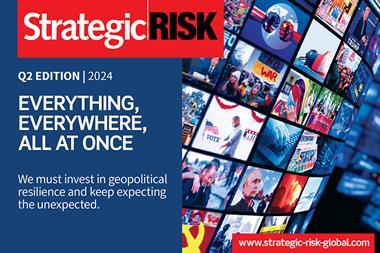Better and greener decision making through risk management was the timely theme for Risk Awareness Week 2021
This year’s Risk Awareness Week 2021, brought together expert speakers from across the globe, giving presentations on a wide range of themes. Sessions gave practical tips on everything from understanding uncertainty to how perception and risk psychology influences decision making.
The theme for the week was better and greener decision making through risk management. Sessions were specifically focused on achieving better planning, performance management and governance through decision science and modern risk management tools.
One of the core aims of Risk Awareness Week is to bring risk management to non-risk professionals who would benefit from its concepts and ideas the most. To empower them to enhance corporate and personal decision-making through better use of risk management tools and techniques.
For risk managers, the aim is to embrace more modern mathematical tools to progress to Risk Management 2.0. This means moving away from blunt instruments such as heat maps and risk appetite statements, and instead getting to grips with more sophisticated analytics such as Monte Carlo simulations.
By doing this, the risk management profession can truly enable better board-level decision making and turn threats into opportunities.
The good news is that there is a select number of techniques and tools, which, once learnt, can be applied to any risk whether narrow or broad. The modelling principles and quantification of uncertainties, the move away from averages and avoiding human bias is the same no matter what the situation.
That means these mathematical models can be used for any type of risk, whether that’s cyber, floods, fire, investment risk and so on.
The conference was split across five days, each with a different focus. Throughout the week, an impressive line-up of speakers shared practical case studies on integrating risk management into climate and environmental decision making, planning, project management and risk-adjusted performance management.
The first day was dedicated to governance and the future of risk management. Key learnings included:
- How to establish relationships with boards
- How to turn risk into risk capital and create shareholder value
- How to link risk with strategy, finance and treasury departments.
On day two, speakers shared practical step-by-step workshops showing how to apply quantitative risk analysis to climate and environmental decisions.
Key learnings included:
- How to bring mathematical techniques to narrow risks such as fire and flood modelling
- Why the flow of averages is one of the most fundamental issues in risk management
- How to convince businesses to move away from deterministic average scenarios
- Using scenarios as a simple a tool to move into more risk-based decision making
- How to use Monte Carlo simulations and seamlessly integrate stochastic analysis into decision making.
The top session, which was run by Mariia Kozlova, a post-doctoral researcher at LUT University, looked at making sense of uncertainty, specifically in the context of climate-based decisions.
Day three focused on risk perception with practical workshops examining how to overcome biases, how to deal with heuristics and how to improve expert judgments.
Key learnings included:
- Why the human brain is built in a way that doesn’t comprehend risk and we ignore risk and biases in decision making
- How to calibrate expert judgements and individual risk perceptions using statistical models
- The importance of being mentally and physically prepared for unexpected events
- How to communicate risk effectively with the business and the importance of first impressions
The top session of the day, which was by Christian Hunt, the founder of Human Risk, explored how our perception of risk impacts our view of it and why things that are salient to us, take on a greater significance than things that aren’t.
He argued that by understanding how our brains perceive risk, we can design risk management programs that can compensate for the biases inherent in human thinking to deliver better outcomes.
Day four focused on how to integrate risk tools and techniques into project management. Sessions explored how to apply quantitative risk analysis to make better schedule, budgeting and CapEx decisions for everything from small investments to large construction projects.
Key learnings included:
- The practical application of managing uncertainties in cost, schedule and technical risk
- Understanding parametric models and different approaches to modelling uncertainty
- How to model environmental constraints on capital projects
- Case studies on using stochastic thinking to improve project decisions
The top session was One of the most popular sessions was: A Beginner’s Path to Probabilistic Project Scheduling, by William W Davis, a senior project manager at NCCI Holdings, Inc.
Davis shared how he successfully used nothing more than Microsoft Excel and a pre-built, freely-licensed spreadsheet called Statistical PERT to create a 10-month schedule at the activity level for a major upgrade of his employer’s enterprise resource planning (ERP) software.
Day five examined how to use risk management techniques such as quantitative risk analysis in important business, investment and insurance decisions. Speakers gave practical workshops which provided step-by-step guides on how to apply these risk management tools to improve decision making.
Key learnings included:
- Understanding Bayes theorem and Bayesian inference
- Applying Monte Carlo to quantify legal and compliance risks
- Writing a simulation for risks that are difficult to quantify
- Why brokers are often underinformed about risk
- How take data from external databases and publicly available sources and use them in your models
The top session of the day was quantify legal and compliance risks from zero to hero, a workshop by Professor Hernan Huwyler, IT risk senior lead at IE Law School.
Huwyler explained how to change insurance and control provisions by using an estimator tool to calculate loss expectancy curves on contractual, regulatory, criminal and privacy risks.
Attendees learnt how to use simple MS Excel formulas to model risks based on common distributions and how to collect and validate risk data on legal assessments.
You can catch up on all the sessions from across all five days of Risk Awareness Week here. There are also key resources available for download, including free sample models, book extracts, presentations and more.




















No comments yet